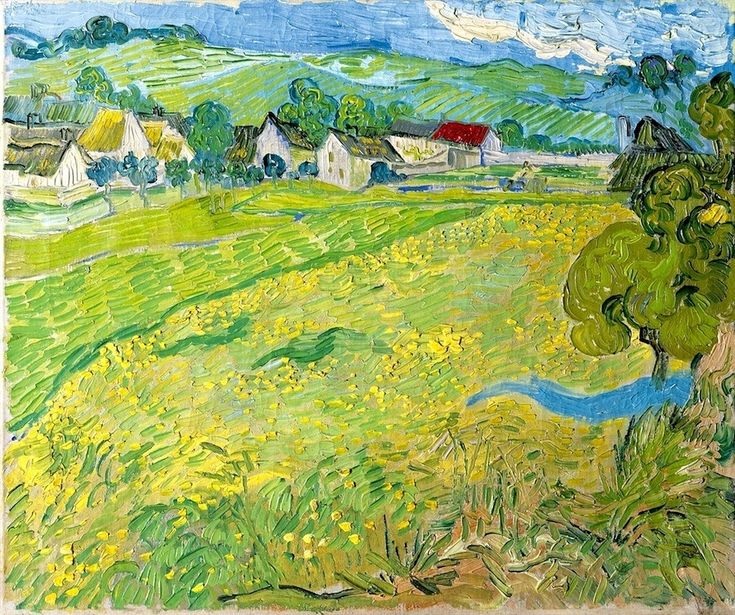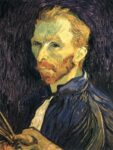
Vincent Van Gogh
Dutch, 1853–1890 (active France)
Les Vessenots in Auvers, 1890
oil on canvas
21 5/8 × 25 9/16 in.
Museo Nacional Thyssen-Bornemisza, Madrid

Van Gogh - Self-Portrait, August 1889
“Here we’re far enough from Paris for it to be the real countryside, but nevertheless, how changed since Daubigny. But not changed in an unpleasant way, there are many villas and various modern and middle-class dwellings, very jolly, sunny and covered with flowers. That in an almost lush countryside … beautiful greenery in abundance and in good order.” – Letter to Theo, 25 May 1890
COMMENTS
This landscape of ‘Les Vessenots,’ on the outskirts of Auvers, shows a group of old country cottages placed just below a raised horizon; further down, wheat fields stretch to the bottom of the canvas, broken only by a few swaying trees. The narrow color range—mainly bright greens and yellows—and the nervous, agitated brushstrokes following a repetitive, undulating rhythm, are characteristic of the artist’s work in his final period.
Van Gogh painted a large number of landscapes in the weeks before his death, always working outdoors. By that time, he was prey to all manner of conflicting moods: the vast expanses of fertile cropland gave him a sense of freedom, but at the same time intensified the feeling of melancholy and loneliness which would eventually lead to his suicide.
On 20 May 1890 Vincent van Gogh left Paris for Auvers-sur-Oise, a small village thirty-five kilometers north of Paris where other artists like Charles Daubigny and Paul Cézanne had sojourned before him and the place of residence of Doctor Paul-Ferdinand Gachet, the physician and art collector to whom Theo van Gogh entrusted the care of his brother Vincent’s health at the recommendation of Camille Pissarro. Despite lasting scarcely two months, the Auvers period was extremely productive. During what would be the last weeks of his life, Vincent painted a few portraits and numerous landscapes including “Les Vessenots, ” the area of Auvers where Doctor Gachet, the first owner of the painting, lived.
As in other paintings from this final period, the artist combines a composition with a high horizon featuring a group of old country houses, some with thatched roofs, vast cornfields and a few swaying trees, with a reduced palette of luminous greens and yellows and agitated, nervous brushstrokes applied in an undulating, repetitive pattern. As Guillermo Solana noted in his study on the painter’s final period, the high horizon is what distinguishes these Auvers landscapes from those of possible forerunners like Daubigny and George Michel and from seventeenth-century Dutch painting and furthermore constitutes “a general characteristic of the advanced landscape painting of the second half of the nineteenth century.”
Although Van Gogh painted from life, with the subject before him, he shows us an absolutely personal vision and gives visual form to his impressions of what he gazes at. The fertile meadows around Auvers aroused conflicting feelings in him: the sensation of freedom inspired by these broad fields contrasted with the melancholy and feeling of loneliness they brought on. It would be one of these corn fields that he repeatedly painted during the final weeks where, overwhelmed by contradictory feelings and suffering another relapse in his deep-seated depression, Van Gogh put an end to his eventful existence …
- Paloma Alarcó, Museo Nacional Thyssen-Bornemisza, Madrid, 2021
https://www.museothyssen.org/en/collection/artists/gogh-vincent-van/vessenots-auvers
SBMA CURATORIAL LABELS
In a period of astonishing productivity, Vincent produced seventy-two paintings, thirty-three drawings, and one print in the two months before his premature death, most of them landscapes. This striking canvas captures Vincent’s mature approach to landscape in this period, synthesizing the network of artistic influences he found in Auvers.
A small village with an outsize artistic reputation, Auvers attracted painters such as Charles-François Daubigny, Camille Pissarro, and Paul Cézanne several decades before Van Gogh arrived in 1890. Vincent’s approach to working directly from nature in Auvers drew on the essence of his hero Daubigny’s artistic practice, who famously painted from his floating studio, nicknamed “Le Botin” (the little boat). At the same time, the unusually high horizon line and vibrant yellow stippling in "Les Vessenots" call to mind the more avant-garde landscapes of Pissarro and Cézanne, whose works Vincent recorded seeing at Dr. Gachet’s house.
- Through Vincent's Eyes, 2022
